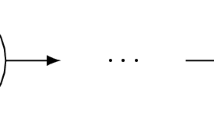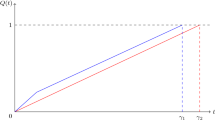Abstract
Simply because of their rarity, the estimation of the statistics of buffer overflows in well-dimensioned queueing networks via direct simulation is extremely costly. One technique that can be used to reduce this cost is importance sampling, and it has been shown previously that large deviations theory can be used in conjunction with importance sampling to minimize the required simulation time. In this paper, we obtain results on the fast simulation of tandem networks of queues, and derive an analytic solution to the problem of finding an optimal simulation system for a class of tandem networks ofGI/GI/1 queues.
Similar content being viewed by others
References
H. Kahn, Use of different Monte Carlo sampling techniques, in:Proc. Symp. on Monte Carlo Methods, University of Florida, ed. H.A. Meyer (Wiley, 1954).
M. Cottrell, J.C. Fort and G. Malgouyres, Large deviations and rare events in the study of stochastic algorithms, IEEE Trans. Auto. Contr. AC-28 (1983) 907–918.
S. Parekh and J. Walrand, A quick simulation of excessive backlogs in networks of queues, IEEE Trans. Auto. Contr. AC-34 (1989) 54–66.
K.S. Shanmugam and P. Balaban, A modified Monte-Carlo simulation technique for the evaluation of error rate in digital communication systems, IEEE Trans. Commun. COM-28 (1980).
M.C. Jeruchim, Techniques for estimating bit error rate in the simulation of digital communications systems, IEEE J. Sel. Areas Commun. SAC-2 (1984).
B.R. Davis, An improved importance sampling method for digital communication system simulations, IEEE Trans. Commun. COM-34 (1986).
M.R. Frater, T.M. Lennon and B.D.O. Anderson, Optimally efficient estimation of the statistics rare events in queueing networks, IEEE Trans. Auto. Contr. AC-36 (1991) 1395–405.
M.R. Frater, J. Walrand and B.D.O. Anderson, Optimally efficient simulation of buffer overflows in queues with deterministic service times, Australian Telecommun. Res. 24 (1990) 1–8.
S.R.S. Varadhan,Large Deviations and Applications (Society for Industrial and Applied Mathematics, Philadelphia, PA, 1984).
Author information
Authors and Affiliations
Additional information
Work supported by Australian Telecommunications and Electronics Research Board (ATERB). The authors wish to acknowledge the funding of the activities of the Cooperative Research Centre for Robust and Adaptive Systems by the Australian Commonwealth Government under the Cooperative Research Centres Program.
Rights and permissions
About this article
Cite this article
Frater, M.R., Anderson, B.D.O. Fast simulation of buffer overflows in tandem networks ofGI/GI/1 queues. Ann Oper Res 49, 207–220 (1994). https://doi.org/10.1007/BF02031598
Issue Date:
DOI: https://doi.org/10.1007/BF02031598




